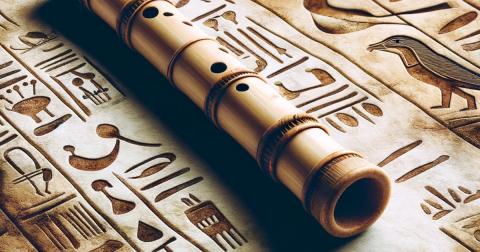The flute is one of the world's oldest musical instruments and has a rich and diverse history spanning several millennia.
The Oldest Flutes in the World
One of the most significant archaeological finds in the study of musical instruments is the so-called Neanderthal flute. Estimated to be around 60,000 years old, it was discovered in Divje Babe, Slovenia, and is believed to be the world's oldest known musical instrument. Made from a cave bear femur, this flute demonstrates that Neanderthals possessed the ability to create and appreciate music.
The next oldest known flute was discovered in the Swabian Jura region of Germany and dates to approximately 35,000 years ago. It was made from the wing bone of a vulture and is known as the Hohle Fels Flute. This ancient flute had five finger holes and a V-shaped mouthpiece, showcasing a level of sophistication in early musical instrument design.
Following the Hohle Fels Flute, numerous other prehistoric flutes have been uncovered. Notably, the Geißenklösterle Flutes, also found in Germany and dating back around 33,000 years, were made from mammoth ivory and bird bones.
Ancient Flutes
In ancient civilizations, flutes played a significant role in cultural and ritual practices. The ancient Egyptians, for example, used flutes made from bamboo and reeds as early as 4000 BC. These flutes were often played in religious ceremonies and were depicted in numerous artworks, indicating their importance in Egyptian society.
The Greeks and Romans also embraced the flute, known as the aulos in Greece and tibia in Rome. These instruments were typically made from wood or bone and had a distinct double-piped design, producing a rich, reedy sound. The aulos was a staple in Greek musical performances, often accompanying dramas and athletic games.
Materials and Craftsmanship
The materials used to make flutes have varied significantly throughout history, reflecting the resources available to different cultures. As noted above, in prehistoric times, flutes were commonly made from bones. The choice of bone was likely due to its durability and the ease with which it could be worked into the desired shape.
As civilizations advanced, the materials used in flute-making expanded. Bamboo, wood, and various reeds - for example the bamboo reed flutes known as xiao from the famous Reed Flute Cave in China - became popular due to their availability and acoustic properties. These materials allowed for more variation in size and tonal quality, leading to the development of flutes with a wider range of sounds.
Metal flutes emerged much later, with the earliest examples dating back to the medieval period. However, it wasn't until the 19th century that metal flutes, particularly those made of silver and gold, gained prominence. The introduction of metal significantly changed the flute's acoustic qualities, leading to the modern flute's brighter and more projecting tone.
Discover more about the significance of flutes in China’s history and China’s famous Reed Flute Cave in the article ‘China’s Reed Flute Cave: A Natural Masterpiece with a Rich History’ available in the November - December 2023 issue of Ancient Origins Magazine. Get it here!
Featured Image: An artistic representation of an ancient Egyptian flute made from bamboo or reeds. Source: Image created by OpenAI's DALL-E
By Alicia McDermott




